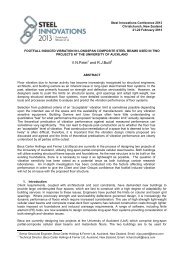Environmental Impacts of Multi-Storey Buildings Using Different ...
Environmental Impacts of Multi-Storey Buildings Using Different ...
Environmental Impacts of Multi-Storey Buildings Using Different ...
You also want an ePaper? Increase the reach of your titles
YUMPU automatically turns print PDFs into web optimized ePapers that Google loves.
- 111 -The following assessment will present the full lifetime GWP for the four buildings using analternative end-<strong>of</strong>-life scenario where the there is no net increase in greenhouse gas emissionsafter the building is demolished. Assumptions and reasons are given below to show why thisis a valid alternative way to present the results <strong>of</strong> this study.The permanent storage scenario is consistent with the carbon sequestered in the woodproducts being retained permanently, that is, in perpetuity, in one <strong>of</strong> the following ways:• Landfill <strong>of</strong> all wood products with no subsequent release <strong>of</strong> greenhouse gas emissions.• Landfill, with any decomposition to methane being collected for energy production.• Re-use <strong>of</strong> all wood products in other new buildings.• Replacement <strong>of</strong> all buildings with new buildings containing at least the same amount<strong>of</strong> wood.An excellent example <strong>of</strong> this ‘permanent storage scenario’ is occurring right now inChristchurch. The old Burwood Landfill is generating methane gas which is being efficientlycollected and used to displace the use <strong>of</strong> other carbon-based fossil fuels in the heating <strong>of</strong> theQEII pool complex. By 2010, the Christchurch City Council will extend the usage <strong>of</strong>methane from Burwood by building additional piping to take the gas to the new City Officesin Central Christchurch.The underlying consideration is that as long as the timber products ‘exist’, they are storingcarbon (or displace other fossil fuel usage, as long as any ‘bad’ products <strong>of</strong> decomposition(eg. methane) are used and not released back to the atmosphere). This approach does notassume any particular end-<strong>of</strong>-life scenario; it doesn’t have to because it simply says thattimber products, that are real and being utilised, store carbon, and there are mechanisms forretaining this ‘beneficial’ storage over the very long term.The Kyoto Protocol does not recognise this approach. It considers all the carbon in wood is100% volatilised at the time <strong>of</strong> harvesting – which it clearly is not – and has led to muchdebate about how to account for carbon storage in timber products.This assessment only uses data already given in Chapter 6 <strong>of</strong> this report, presented in aslightly different way. The discussion will be in three parts; firstly, considering the materialsonly using those GWP coefficients adopted by Scion in the LCA in Chapter 6, thenconsidering the materials only but calculated using figures directly from the LCA inChapter 6, and, lastly, materials combined with all other emissions for the full life cycle over60 years.9.5.1 Materials Only – With Data From GWP Coefficients usedby Scion.The following data is for materials only, not including emissions from operating ormaintaining the building over its life. A simplified assessment, which only considersemissions from the building materials, is essentially the same as a partial life cycle assessmentwhich considers the building until the end <strong>of</strong> the construction phase (sometime referred to as‘cradle-to-gate’). This scenario more clearly shows the potential benefits <strong>of</strong> retaining thecarbon sequestered in the wood products.
















